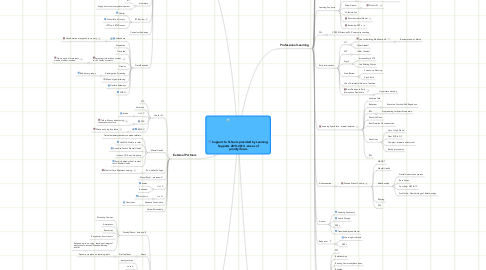
1. Professional Learning
1.1. MANDT
1.1.1. Offer Reguarly
1.1.2. Exec/Board
1.1.3. Admin
1.1.4. Learning Dept
1.1.4.1. school staff
1.2. CoP's - Learning Support Teachers
1.3. ULE Coaches
1.3.1. Kathy Howery
1.3.2. various learning specialists - ex Teresa, Wonyee, Mili, Joan K
1.4. CDAS
1.4.1. Suicide Intervention
1.4.2. Mental Health First Aid
1.4.3. Working with Groups
1.4.4. Rowena/Tammy
1.4.5. Meagan Fillion
1.4.6. Vicarious trauma
1.4.7. MANDT
1.5. Guidance
1.5.1. Documentation/Ethics
1.5.2. Suicide Intervention
1.5.3. Group Treatment
1.5.4. Rowena/Tammy
1.5.5. Behaviour Strategists
1.5.5.1. Applying positive behaviour strategies
1.5.5.2. MANDT
1.5.5.3. Ensuring Policy procedure fidelity
1.5.6. Meagan Fillion
1.5.7. Vicarious trauma
1.6. Positive Behaviour Support
1.6.1. Review
1.7. Psychs
1.7.1. RTI & LD
1.8. Mental Health
1.8.1. Stan Kutcher - teenmentalhealth.org
1.9. SEL
1.9.1. Friends
1.9.2. Relationships
1.10. Cultural Competency
1.10.1. Engaging diverse ethnicities - focusing this year on East Indian families? Bridges Foundation partnering?
1.10.2. FNMI
1.10.3. CCIS, Bridges
1.11. Learning Supports
1.11.1. Inquiry- Invite Barry/Josh to meeting to explore further
1.11.2. RVS 3YP
1.11.2.1. Involve Whole Team in the Process
1.11.3. Wrap-Around
1.11.3.1. Plan for PL
1.11.4. Collaboration
1.11.5. Transtheoretical Model
1.11.6. Reviewing SEP's
1.12. FSL
1.12.1. COPE Efficiencies/PL/Community coaching
1.13. Early Intervention
1.13.1. OT
1.13.1.1. Use for Building Modifications?
1.13.1.1.1. Review at end of March
1.13.1.2. Older Grades?
1.13.2. SLP
1.13.2.1. Older Grades?
1.13.3. Psych
1.13.3.1. Increase Psych FTE
1.13.3.2. Use Existing Psychs
1.13.4. Area Review
1.13.4.1. Succession Planning
1.13.4.2. Psych Role
1.13.5. Use of Assistants/Aides vs Teachers
1.13.6. Best Practices in Early Intervention Provincialy
1.13.6.1. Have Intern develop
1.14. Learning Specialists - internal/external
1.14.1. Assistive Tech
1.14.2. Behaviour
1.14.2.1. Executive Function/Self-Regulation
1.14.3. IPPs
1.14.3.1. Programming for Specific Learners
1.14.4. Transition Plans
1.14.5. Best Practices Documentation
1.14.6. Transitions
1.14.6.1. Out of High School
1.14.6.2. From ECS to G1
1.14.6.3. Complex- internal and external
1.14.6.4. Revise procedures
1.14.7. IPPs
1.15. Adminstration
1.15.1. Positive School Culture
1.15.1.1. MANDT
1.15.1.2. Mental Health
1.15.1.3. Relationships
1.15.1.3.1. Neufeld maturation process
1.15.1.3.2. Ross Green
1.15.1.3.3. Coaching: WW & TF
1.15.1.3.4. Stan Tatkin- Neurobiology of Relationships
1.15.1.4. Bullying
1.15.1.5. SEL
1.16. Autism
1.16.1. Learning Assistants
1.16.2. Jaimie Waugh
1.16.3. PBS's
1.16.4. Transition beyond school
1.17. Behaviour
1.17.1. Learning Assistants
1.17.2. PBS's
1.18. Parents
1.18.1. PPP
1.18.2. Relationships
1.18.3. Existing Community Resources
1.18.4. Reading
1.18.5. Body image
1.18.6. IPPs, Advocacy for parents
1.18.7. Bullying
1.18.8. Digital citizenship
1.18.9. Addictions
1.19. Assistants/Paraprofessionals
1.19.1. Specialized training- g-tube etc
2. Communication
2.1. Webpage
2.1.1. Internal
2.1.1.1. Forms
2.1.1.2. FSL web portal
2.1.1.3. Learning Supports Handbook
2.1.2. External
2.1.2.1. Parent courses
2.1.2.2. Bullying
2.2. digital presence/network of learning support team
2.2.1. Google +
2.2.2. Twitter
2.2.3. Pinterest
2.3. Procedures Handbook
2.3.1. Restraints
2.3.2. Seclusion
2.3.3. Transitions
2.3.3.1. Internal
2.3.3.2. External
2.3.4. Risk/Threat Assessment
2.3.5. Third Party Services
2.3.6. Referral Process
2.3.7. IPP, Adapted Programs, Modifications
2.3.8. Reporting
2.3.8.1. Documenting practice
2.3.8.2. Critical incidents
2.3.9. Review whole handbook
2.3.10. Positive Niches
2.3.11. RCCA
2.3.12. Standard Response for children who display aggression
2.3.13. Exam accomodations
2.3.14. COPE
2.3.15. Concern resolution
2.3.16. FSL documentation
2.3.17. Bullying Response- Best Practices
3. Programming Best Practices
3.1. Assistive Tech
3.1.1. Text to Speech
3.1.2. Speech to Text
3.1.3. Audio and Video assessment
3.2. Gifted
3.2.1. Digital Network
3.2.2. Link with existing CofPs
3.2.3. Flexible Pathways Ab Ed Project- Kristy
3.2.3.1. Muriel Clayton Project
3.2.4. Access to mentors
3.2.5. Twice exceptional
3.3. Assessment
3.3.1. Alternative assessment practices
3.3.2. Modifications
3.3.3. Accomodations
3.3.3.1. Assess in G10 wherever possible
3.3.4. School-Based Assessment tools
3.3.4.1. Level B?
3.3.4.2. PAL-2
3.3.5. SOS-Q
3.3.5.1. Link to Attendance
3.3.5.2. Use as screening for intervention
3.4. Learning Disabilities
3.5. RTI?
3.6. Inclusion
3.7. Support to Families
3.7.1. FSL Best Practices
3.8. PBIS
3.9. Allocation Review - ongoing
3.10. Literacy
3.10.1. Right to Read
3.10.2. All Teachers need to be expert reading teachers
3.10.3. RTI
3.10.4. AARI (U of A)
3.10.4.1. Arrange PL
3.11. Numeracy
3.11.1. RTI
3.11.2. Supports for numeracy development
3.12. IPP Review
3.12.1. Charter
3.12.2. Consultation Process
3.12.3. IPP Tools RDI Process
3.13. Curriculum Redesign
3.14. Data/Research
3.14.1. Attendance
3.14.1.1. Proceduralize a response to truancy
3.14.2. Suspension
3.14.3. Discipline
3.14.4. Parenting/Information courses for 40 Coded students
3.14.4.1. Opt-in option for parents when a student is coded
3.14.5. Grades
3.14.6. Kindergarten Screening
3.14.6.1. Behaviour groups
3.14.7. TRIM and digital archiving
3.14.8. Flexible Pathways
3.14.9. SOS-Q
4. External Partners
4.1. Use for PL
4.1.1. STA
4.1.2. Ambrose
4.1.3. U of C
4.1.3.1. Interns
4.1.4. ATA
4.1.4.1. Talk to Manny about using these sessions more
4.1.5. REACH
4.1.5.1. We need to replace these
4.2. Mental Health
4.2.1. Train elementary teachers to make referrals
4.2.2. Use SOS-Q data to refer
4.2.3. Advertise Access Mental Health
4.2.4. Invite to CDA and Guidance
4.2.5. Send Updated school contact list to Mental Health
4.3. Bow Valley College
4.3.1. Medical Care Attendant training
4.4. Mount Royal - practicums?
4.5. U of C
4.5.1. Interns
4.5.2. Research
4.6. U of L
4.6.1. Practicums
4.7. Sinneave Foundation
4.7.1. Transitions
4.8. Autism Partnership
5. Prevention/Intervention
5.1. Poverty/Stress - time and $
5.1.1. Parenting Courses
5.1.2. Awareness
5.1.3. Resources
5.1.4. Responses from schools
5.1.5. Responding to poverty - teaching strategies? best school practices?blended learning - adults?
5.2. Stress
5.2.1. Staff wellness
5.2.1.1. Pressure we place on teaching staff
5.3. ELL
5.3.1. best practices
5.3.2. vocab
5.3.3. translation support
5.3.4. translation apps
5.3.5. partners?
5.3.5.1. Calgary Catholic Immigration Society
5.3.6. Diploma exams
5.4. Social-Emotional Learning
5.4.1. Relationships
5.4.1.1. Sex ed
5.4.2. Friends/Staff Support
5.5. Mental Health
5.5.1. Stepping Stones
5.5.1.1. Resources
5.5.1.2. Addictions
5.5.1.3. Mental Wellness
5.5.1.3.1. Resiliency
5.5.1.3.2. Coping Skills
5.5.1.4. Mental Illness Awareness
5.5.1.5. groups
5.5.1.5.1. Girl's Circle/Boys Council
5.5.1.5.2. Friends for Life
5.5.1.5.3. "Deal With It" Anxiety Program
5.5.2. Stan Kutcher
5.5.3. Friends
5.6. Bullying
5.6.1. Best Practices
5.6.1.1. Positive School Culture
5.6.2. Digital Citizenship
5.6.3. Parent Resources
5.6.4. Weight bias
5.6.5. LGQBT
5.6.5.1. Calgary Sexual Health?
5.7. Physical Health
5.7.1. Eating disorders
5.7.2. Impact on Learning
5.7.3. Impact of mental health
5.7.4. Food environment in schools
5.7.5. School nurse and other external health services access
